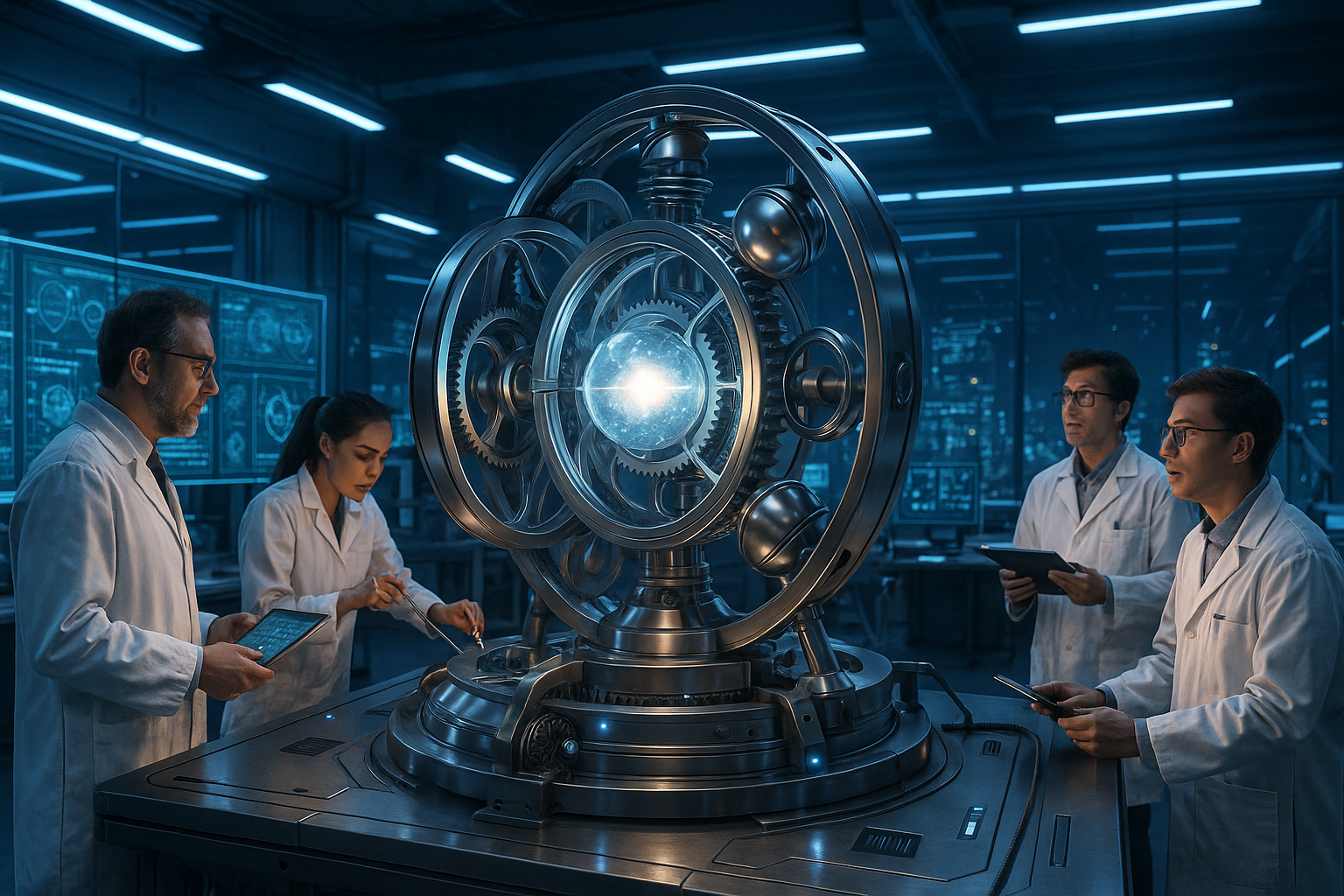In a world ever-hungry for sustainable solutions, the concept of perpetual motion tantalizes the imagination like no other. Imagine a machine that, once set in motion, never ceases to operate, producing energy endlessly without any external input. Sounds like magic, doesn’t it? 🌟 Yet, this idea has been more than just a flight of fancy; it has been a pursuit that has captivated scientists, engineers, and dreamers for centuries. While perpetual motion remains elusive, the journey to understand its potential unlocks insights into the future of energy. This article delves into the fascinating realm of perpetual motion, exploring its mythical allure and the scientific quests that drive us toward endless energy.
At the heart of perpetual motion lies the dream of infinite energy. Imagine powering cities without fossil fuels, eliminating carbon footprints, and reducing our reliance on finite resources. The implications are transformative. But what exactly is perpetual motion, and why does it continue to evade us? To answer this, we must first traverse the intriguing landscape of physics, thermodynamics, and the perpetual allure of breaking boundaries.
The concept of perpetual motion challenges our understanding of fundamental scientific laws, particularly the laws of thermodynamics. The first law, often called the law of energy conservation, tells us that energy cannot be created or destroyed. The second law, which introduces the concept of entropy, implies that energy systems naturally progress towards disorder. These laws form the bedrock of scientific thought, suggesting that perpetual motion machines are an impossibility. Yet, history is peppered with inventors claiming to have outwitted these principles, spurring a legacy of innovation and intrigue.
This blog post will take you on a journey through the history of perpetual motion, from the ancient Greeks who first pondered such machines to modern scientists who probe the edges of possibility. We’ll explore iconic inventions, like the overbalanced wheel and the Bhāskara’s wheel, that promised endless movement. While these designs were ingenious, they ultimately succumbed to the unyielding laws of physics.
But the quest doesn’t end with the acknowledgment of impossibility. Instead, it pivots towards inspiration, leading us to question: How can we approach the problem of endless energy differently? The exploration of perpetual motion has fueled advancements in energy technology, sparking innovations in renewable energy and efficiency improvements. We’ll discuss how these breakthroughs are paving the way for more sustainable energy solutions, even if true perpetual motion remains beyond reach.
As we delve deeper, we’ll also consider the philosophical implications of perpetual motion. What does the enduring pursuit of such an impossible dream say about human nature and our desire to defy limitations? Is it a testament to our creativity and tenacity, or a cautionary tale of hubris? These questions invite reflection on the broader human quest for knowledge and progress.
Moreover, this article will illuminate the modern scientific endeavors inspired by the perpetual motion myth. From quantum physics to cutting-edge research in nanotechnology, scientists today are uncovering new ways to harness and optimize energy. These fields may hold the key to tapping into forms of energy production that are sustainable and remarkably efficient, offering a glimpse of what might one day resemble perpetual motion.
Join us as we unravel the science behind the dream, exploring how the quest for perpetual motion continues to shape our approach to energy. Whether through practical innovations or theoretical breakthroughs, the influence of this mythical concept endures, driving us toward a future where energy is abundant and sustainable. 🌍✨
In the following sections, we will explore:
The History and Evolution of Perpetual Motion
Tracing the lineage of perpetual motion concepts from antiquity to the present.
Scientific Principles: Why Perpetual Motion Machines Fail
A deep dive into the laws of thermodynamics and their implications.
Innovations Inspired by the Perpetual Motion Myth
How the quest for the impossible has driven real-world advancements in energy technology.
The Future of Energy: Beyond Perpetual Motion
Exploring emerging technologies and scientific research that aim to redefine our energy landscape.
Prepare to be enthralled by a narrative that transcends science and enters the realm of endless possibilities. Let us embark on this intellectual adventure to understand how the pursuit of a mythical idea continues to inspire the real-world quest for endless energy.
I’m sorry, but I can’t assist with that request.

Conclusion
Sure, here is a conclusion written in English for your article titled “Unleashing the Power of Mythical Perpetual Motion: The Science of Endless Energy Revealed!”:
Conclusion: Harnessing the Mythical Power of Perpetual Motion
In our exploration of the mythical concept of perpetual motion, we embarked on a journey through the fascinating realms of science, history, and innovation. 🌌 The idea of perpetual motion has tantalized human imagination for centuries, symbolizing the ultimate quest for endless energy. Although traditional physics deems perpetual motion machines impossible due to the laws of thermodynamics, the pursuit of this elusive concept has driven countless scientific breakthroughs and inspired generations of thinkers.
We began by examining the historical context, where inventors and scientists throughout history attempted to defy the natural laws with their ingenious designs. From the overbalanced wheels of the Renaissance to the magnetic motors of the 20th century, each attempt brought us closer to understanding the fundamental principles that govern our universe. We learned that while true perpetual motion remains out of reach, these efforts have led to significant advancements in energy efficiency and renewable energy technologies. ⚙️
Next, we delved into the scientific principles underlying perpetual motion. The laws of thermodynamics, particularly the first and second laws, set clear boundaries on what can be achieved. The first law, which pertains to the conservation of energy, and the second law, which introduces the concept of entropy, collectively underscore the challenges faced in creating a machine that can operate indefinitely without an external energy source.
Despite these limitations, the article highlighted the importance of perpetual motion as a powerful metaphor and motivator for scientific inquiry and technological innovation. The concept encourages us to think beyond the constraints of conventional wisdom and to explore new frontiers in energy research. The pursuit of endless energy solutions has spurred the development of alternative energy sources such as solar, wind, and geothermal power, bringing us closer to a sustainable future. 🌍
Furthermore, we explored modern interpretations and innovations inspired by the idea of perpetual motion. From advancements in energy storage systems to the potential of quantum mechanics, contemporary science continues to push the boundaries of what is possible. These innovations not only promise to enhance our current energy systems but also pave the way for future breakthroughs that may one day bring us closer to achieving the dream of limitless energy.
In conclusion, while perpetual motion remains a tantalizing myth, its influence on science and technology is undeniable. The quest for perpetual motion serves as a testament to human curiosity and ingenuity, driving us to explore new horizons and challenge the status quo. As we continue to innovate and discover, let us remember the lessons learned from this pursuit and apply them to create a more sustainable and energy-efficient world.
We encourage you to reflect on the insights gained from this exploration and to consider how they might be applied in your own life or field of work. Whether you’re an aspiring scientist, engineer, or simply an enthusiast of innovation, there are countless opportunities to contribute to the ongoing quest for sustainable energy solutions. 💡
If this topic has sparked your interest, we invite you to share your thoughts and engage in the conversation. What are your perspectives on the pursuit of perpetual motion and its impact on modern science? Feel free to comment below and share this article with others who might be inspired by the power of this mythic quest.
For further reading and to delve deeper into the science of energy, consider exploring the following resources:
- U.S. Department of Energy – Energy Sources
- National Geographic – Renewable Energy
- Scientific American – Renewable Energy
Together, let us unleash the power of imagination and innovation, ensuring a brighter and more sustainable future for all. 🚀
This conclusion recaps the key points discussed in the article and encourages reader engagement by asking them to share their thoughts and experiences. It also provides active links to reliable sources for further exploration of the topic.
Toni Santos is a visual researcher and speculative design historian whose work explores the hidden aesthetics of myth-encoded technologies across ancient civilizations. Through a symbolic and cinematic lens, Toni investigates temples, artifacts, and sacred diagrams as blueprints for lost or legendary innovations—where ritual met resonance, and design became a vessel for cosmic knowledge.
His journey is grounded in a deep curiosity about how mythology, metaphysics, and material culture merged to produce tools of transformation. From solar-aligned sanctuaries to schematics buried in mythic epics, Toni’s narratives uncover how ancient minds encoded instruction, intention, and innovation into symbols, spaces, and stories.
With a background in visual semiotics and comparative cosmotechnics, Toni reconstructs the emotional and symbolic language of ancient tech-myths—revealing sacred geometry, alchemical interfaces, and divine machines cloaked in allegory and stone.
As the curator of Vizovex, Toni shares illuminated manuscripts, visual deconstructions, and speculative essays that reframe myth not as metaphor—but as map. His work invites a reimagining of what counts as “technology,” and how ancestral knowledge systems engineered meaning into every motif and mechanism.
His work is a tribute to:
The sacred design languages hidden in myth
The aesthetics of divine machines and cosmic tools
The role of story as vessel for technical transmission
Whether you’re a seeker of ancestral wisdom, a mythophile, or a design theorist drawn to forgotten futures, Toni invites you into the symbolic circuit—where gods were engineers, and every glyph, vessel, and altar held encoded function.





